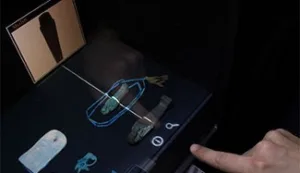An experimental display, using semi-transparent mirrors, has the potential to enable interaction with a wide variety of objects. Developed by the University of Bristol’s Department of Computer Science (DCS), the ‘combining glass’ uses optical combiners and relies on a mirror’s ability to map a reflection to a single unique point behind the mirror – independently of the observer’s location. This means that reflections appear to be overlapping the same point as a user’s own body.
The system uses peoples’ reflections for interaction, rather than their own gestures. For example, used in a museum the display could show more information about objects that the user’s reflection hovers over. The system could also be used by people to try on clothes, using their reflections in a shop window.
Different display technologies can be used in combination. The DCS provides an example: ‘ By placing a projector on top of the cabinet, fingertips could work as little lamps to illuminate and explore dark and sensitive objects. When a hand’s reflection cuts through the object, the projections on visitors’ hands could be used to reveal the inside of the object, which would be visible to any user’.
A video of the system can be viewed at http://tinyurl.com/mbcx93y.

